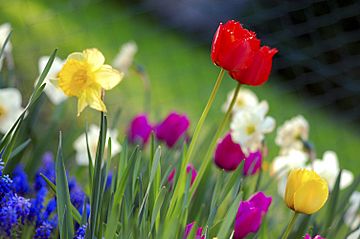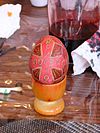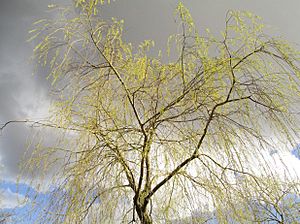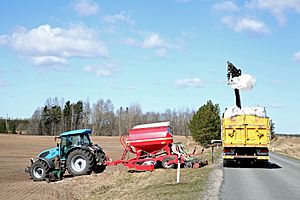Spring facts for kids

Spring, also known as springtime, is one of the four main seasons in places with a temperate climate. It comes after winter and before summer. Spring is often linked to ideas of new beginnings, growth, and nature waking up. When it's spring in the Northern Hemisphere, it's autumn in the Southern Hemisphere, and vice versa. Around the spring equinox, days and nights are about the same length. As spring goes on, the days get longer and the nights get shorter.
Areas near the equator usually don't have seasons like spring, summer, autumn, and winter. Their climates are better described by other terms, such as dry or wet seasons. Different cultures around the world also have their own names for seasons, which might not match the terms we use in Europe.
Contents
When Does Spring Start and End?
There are different ways people define when spring begins and ends. It often depends on where you live and what traditions you follow.
Meteorological Spring Dates
Weather experts, called meteorologists, often divide the year into four seasons based on average monthly temperatures. Each season lasts for three months. The three warmest months are summer, the three coldest are winter, and spring and autumn are in between. This means that the start date for spring can be different in various places.
- In the U.S. and U.K., spring usually includes March, April, and May.
- In Australia and New Zealand, spring starts on September 1st and ends on November 30th.
- In Ireland, following the Gaelic calendar, spring is often considered February, March, and April.
- In Sweden, spring begins when the average temperature stays above freezing (zero degrees Celsius) for seven days in a row. This means the date changes depending on how far north you are or how high up you live.
- In Brazil, spring runs from September through December.
- In India, spring is culturally celebrated in March and April.
Astronomical and Cultural Spring Dates
Some cultures use the position of the Earth and Sun to mark the start of spring.
- In many Northern Hemisphere cultures, like in Germany and the U.K., the March equinox (around March 19th to 21st) marks the first day of spring. Spring then ends at the summer solstice (around June 21st).
- In Persian culture, the first day of spring is the first day of their first month, called Farvardin, which is on March 20th or 21st.
- The traditional Chinese calendar defines spring as the time between Lichun (February 3rd–5th) and Lixia (May 5th–7th), with Chunfen (March 20th–22nd) as its middle point.
- According to Celtic tradition, which looks at daylight hours and the strength of the sun, spring starts in early February (around Imbolc) and lasts until early May (Beltane).
What Happens in Nature During Spring?
During early spring, the Earth's tilt towards the Sun increases. This makes the days get longer very quickly in the hemisphere experiencing spring. As a result, the air and ground start to warm up a lot. This warmth helps new plants to grow and "spring forth," which is how the season got its name!
If there was snow, it begins to melt, filling streams with water. Freezing temperatures become less common. In places that don't get snow or much frost, the temperatures rise even faster.
Many flowering plants bloom during spring. They often bloom one after another, starting even when there's still snow on the ground and continuing into early summer. In areas that usually don't get snow, spring might start as early as February (in the Northern Hemisphere) or August (in the Southern Hemisphere). You can see this when trees like magnolias, cherries, and quince start to bloom.
Some places have a dry spring and a wet autumn. This pattern helps plants bloom in spring because they get the water they need along with the warmth. Very cold subarctic areas might not really experience "spring" until May.
Spring Weather and Storms
While spring is caused by the Earth's tilt, the weather can still be unpredictable. This is because warm air from warmer places starts to mix with cold air still coming from the polar regions.
- Flooding is common in and near mountains during spring. This happens when melting snow combines with warm rains.
- In North America, an area called Tornado Alley sees a lot of tornadoes in spring. This is because the Rocky Mountains stop warm and cold air masses from spreading out, forcing them to clash directly.
- Besides tornadoes, powerful supercell thunderstorms can also bring very large hail and strong winds. Weather warnings are often issued for these storms.
- Fast-moving air currents high in the atmosphere, called jet streams, play a big role in creating unstable and severe weather in the Northern Hemisphere during spring.
Scientists have noticed that many signs of spring are happening earlier now. This is called "season creep," and it means spring events are occurring about two days earlier each decade.
Southern Hemisphere Spring Differences
Spring in the Southern Hemisphere is different from the Northern Hemisphere for several reasons:
- There's no land connecting Southern Hemisphere countries to the Antarctic zone. This means cold air coming from there has to cross a lot of ocean, which makes it warmer.
- The Southern Hemisphere has much more ocean than land at most latitudes.
- The Earth's orbit currently brings it closer to the sun during the Southern Hemisphere's warmer seasons.
- There's a strong, continuous flow of air around the South Pole, known as the "roaring 40s and 50s," which isn't broken up by large landmasses.
- There are no similar jet streams in the Southern Hemisphere.
- The ocean currents in the Pacific Ocean also behave differently.
Cultural Celebrations in Spring
Many cultures celebrate spring with special events and holidays.
Carnival
Carnival is a celebration held by many Christians around the world. It takes place in the days before Lent, which is a 40-day period before Easter. For many, Carnival is the first spring festival of the new year.
Easter

Easter is a very important religious holiday for Christians. They believe that Jesus came back to life on the "third day" after his crucifixion. Easter Day celebrates this event. The date of Easter changes each year, falling between March 22nd and April 25th. In the Southern Hemisphere, Easter happens during their autumn. A fun tradition for children during Easter is the Easter egg hunt.
May Day
May 1st is a public holiday in many countries. In many places, May Day is also known as International Workers' Day or Labour Day. This day celebrates the achievements of workers and their rights.
May Day also has very old traditions. Many customs come from May Day being a "cross-quarter day." This means it falls about halfway between the spring equinox and the summer solstice in the Northern Hemisphere, where it is mostly celebrated. In Celtic tradition, May Day marked the end of spring and the start of summer.
Images for kids
-
Holi festival in Nepal, 2016
See also
 In Spanish: Spring para niños
In Spanish: Spring para niños







